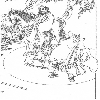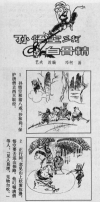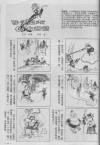Chapter 6: Comics and Cultural Revolutions in China
In the 1970s, there were quite a few comics! We read them all: the Dream of the Red Chamber, the Water Margin, and the Journey to the West, too. We thought those heroes in the stories were great! The new comics were not so interesting [沒有味儿 mei you wei’r], they were very basic. (Housekeeper, 1950s–)
I was on an artistic team then, because I liked painting. So we would paint comics, for example, in the early 1970s. I was a worker and so I took part in these activities. Most of what we painted was rote—Mao’s portrait, for example. We did a lot of exhibitions then, too. We painted heroes, local heroes as well as national heroes, those who sacrificed themselves for others. And, of course, we also painted scenes from the model works. (Musicologist, 1950s–)
During the Cultural Revolution, many of the old comics were destroyed, but still, they would be read: I would read at home with my younger brother. But there was always this fear of Red Guards coming and Smashing the Four Olds” [破四旧 po si jiu], so there was a difficulty with having such things at home. After having read them, therefore, we decided, piece by piece, whether it was safe to keep them. There was this comic strip on the Song hero Yue Fei [岳飞 (1103–42) which was a set of six little comic books: we decided to keep it. (Intellectual, 1958–)
Chinese comics, in the form of small rectangular pocket-size books (ca. 9x13 cm) called “small people’s books” (小人书 xiaorenshu) and containing narrated pictures called “chain(ed) pictures” (连环画 lianhuanhua), have been the most characteristic and dominant form of comic popular in China since the 1920s and at least until the late 1980s (Seifert 2008, 66). According to Chinese media reports (e.g. Wenhuibao 8.4.1962), as well as Western observers (e.g., Nebiolo 1973), and the memories of Chinese informants, these chain pictures would have been cheaply available not just in urban areas but arguably also in remote areas of China, and almost anywhere: at the barbershop, on trains, at the hospital, and on the street. Thus, by the very nature of the medium, they may be considered the most popular of all art forms throughout the twentieth century, not only during the Cultural Revolution (Seifert 2008, 15).
And thus they may indeed have “planted the seeds for ideals and knowledge in the hearts and souls” of China’s youngsters, as Jiang Weipu, one of the more famous comic artists and chroniclers of comic art in China has stated (DACHS 2008 Liu Xiaoming, Comics). And indeed, one composer remembers: “When I was a child I would read lots of books, many of them in the form of chained pictures. ... We always liked them; they gave us a kind of moral feeling [道德感 daode gan]” (Composer, 1937–).
Remarks such as these suggest that (Cultural Revolution) comics are a culturally constitutive form: they create and support particular visual codings and through them fashion a particular habitus (Seifert 2008, 8–9). This study ends with a study of these types of comics, so popular during the Cultural Revolution and beyond, as they appear to be in many ways the ultimate form of Cultural Revolution cultural production: they combine and repeat, as a composite, the most important and typical aspects of this culture. They present themselves as stories of the ordinary and the everyday for all to consume, and they draw on all the different elements important to Cultural Revolution Culture as discussed throughout, MaoMusic, MaoSpeak, and MaoArt among them.
By analyzing comics from the Cultural Revolution, then, the different threads spun out throughout the book accompanying this database can be woven together. I argue, first, that Cultural Revolution Culture, as manifested in Cultural Revolution comics, brought to an extreme what had been practiced for many years before, and epitomized what would remain important even decades later. Only in constituting an art form that, at least in theory, was completely univalent, an art that “chained” the reader to think and believe only one and the same thing, did Cultural Revolution comics differ from the chained pictures dating from before and after this period. However, and this is the second argument here and throughout this study, the idea of univalence of meaning in itself was not created during the Cultural Revolution. Many of the arguments used and abused during the Cultural Revolution to streamline Cultural Revolution art and cultural production can be traced back to ideas that came into being in the early twentieth century, and, most importantly, during a period that is now often considered the most “liberal” period in modern Chinese Cultural history: the other cultural revolution, the May Fourth Movement.
This chapter provides more evidence to show that the radical “hysterics” of Cultural Revolution cultural production have important precedents in the May Fourth Movement, including the destruction of the Confucian heritage and, most important for my discussion here, the idea of creating a new audience, the masses. This idea was not successfully implemented during the May Fourth period. May Fourth art, in spite of its proletarian ideals and leanings, remained elitist. It was later Cultural Revolution art and culture that succeeded in reaching what had been a May Fourth goal originally, of “popularization” (大众化 dazhonghua).
The popularity of Cultural Revolution (comic) art in recent years, which finds its reflection on websites featuring “nostalgic comic collections” entitled “Red Classics” (红色经典) or “Red Memory” (红色记忆) and lavish blown-up re-publications of this particular comic art, seems to point in this direction (DACHS 2009 Cultural Revolution Comics: Red Memories). This again puts into question the claim of univalence of Cultural Revolution art, because its recent popular reception, as seen so clearly in previous chapters, also thrives on ambiguities of interpretation. And this brings me one of the major arguments: it is worthwhile to question our perception of the redundantly repetitive and restrictive quality of Cultural Revolution art that has been emphasized in many a study on Chinese cultural production during the Cultural Revolution.
If looked at more closely, Cultural Revolution art and culture actually allowed for quite a few variations; it allowed for foreign and for Chinese traditional elements to play a role, for example. Most importantly, the Cultural Revolution cannot be seen as a single period that produced only one type of homogenous cultural product. Cultural production in the late 1960s, to give but one example, differed significantly from that in the early 1970s. In chapter 6 I discuss further evidence for this phenomenon.
Moreover, the theoretical ideal of what constituted Cultural Revolution Culture—as envisaged by the cultural makers around Jiang Qing—and the practical experience of what kinds of art and culture were in fact available during the Cultural Revolution (including much that was not actively and officially produced but was nevertheless available all throughout this period) were very much at variance: the experience of art and culture during the ten years now called the Cultural Revolution was neither singular nor straightforward. It differed substantially depending on the class background of a particular individual, his or her geographical location, educational background, and closeness to high revolutionary personnel, to mention but a few variables.
The cultural experience of the Cultural Revolution, hitherto still understudied, is much more complicated than what mainstream talk of cultural stagnation would make of it. It is the purpose of chapter 6 to probe, one last time, into this unique but not all that exceptional experience.


















































































